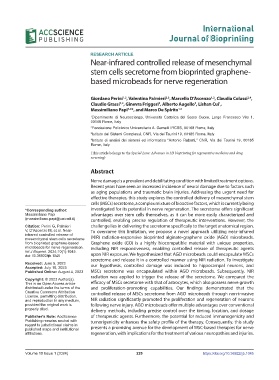Page 237 - IJB-10-1
P. 237
International
Journal of Bioprinting
RESEARCH ARTICLE
Near-infrared controlled release of mesenchymal
stem cells secretome from bioprinted graphene-
based microbeads for nerve regeneration
Giordano Perini , Valentina Palmieri , Marcello D’Ascenzo , Claudia Colussi ,
1,2
1,2
2,4
2,3
Claudio Grassi , Ginevra Friggeri , Alberto Augello , Lishan Cui ,
2
1,2
1
2
Massimiliano Papi *, and Marco De Spirito 1,2
1,2
1 Dipartimento di Neuroscienze, Università Cattolica del Sacro Cuore, Largo Francesco Vito 1,
00168 Rome, Italy
2 Fondazione Policlinico Universitario A. Gemelli IRCSS, 00168 Rome, Italy
3 Istituto dei Sistemi Complessi, CNR, Via dei Taurini 19, 00185 Rome, Italy
4 Istituto di analisi dei sistemi ed informatica “Antonio Ruberti,” CNR, Via dei Taurini 19, 00185
Rome, Italy
(This article belongs to the Special Issue: Advances in 3D bioprinting for regenerative medicine and drug
screening)
Abstract
Nerve damage is a prevalent and debilitating condition with limited treatment options.
Recent years have seen an increased incidence of neural damage due to factors such
as aging populations and traumatic brain injuries. Addressing the urgent need for
effective therapies, this study explores the controlled delivery of mesenchymal stem
cells (MSCs) secretome, a complex mixture of bioactive factors, which is currently being
*Corresponding author: investigated for its potential in nerve regeneration. The secretome offers significant
Massimiliano Papi advantages over stem cells themselves, as it can be more easily characterized and
(massimiliano.papi@unicatt.it) controlled, enabling precise regulation of therapeutic interventions. However, the
Citation: Perini G, Palmieri challenge lies in delivering the secretome specifically to the target anatomical region.
V, D’Ascenzo M, et al. Near- To overcome this limitation, we propose a novel approach utilizing near-infrared
infrared controlled release of
mesenchymal stem cells secretome (NIR) radiation-responsive bioprinted alginate-graphene oxide (AGO) microbeads.
from bioprinted graphene-based Graphene oxide (GO) is a highly biocompatible material with unique properties,
microbeads for nerve regeneration. including NIR responsiveness, enabling controlled release of therapeutic agents
Int J Bioprint. 2024;10(1):1045.
doi: 10.36922/ijb.1045 upon NIR exposure. We hypothesized that AGO microbeads could encapsulate MSCs
secretome and release it in a controlled manner using NIR radiation. To investigate
Received: June 5, 2023
Accepted: July 10, 2023 our hypothesis, controlled damage was induced to hippocampal neurons, and
Published Online: August 4, 2023 MSCs secretome was encapsulated within AGO microbeads. Subsequently, NIR
radiation was applied to trigger the release of the secretome. We compared the
Copyright: © 2023 Author(s).
This is an Open Access article efficacy of MSCs secretome with that of astrocytes, which also possess nerve growth
distributed under the terms of the and proliferation-promoting capabilities. Our findings demonstrated that the
Creative Commons Attribution controlled release of MSCs secretome from AGO microbeads through non-invasive
License, permitting distribution,
and reproduction in any medium, NIR radiation significantly promoted the proliferation and regeneration of neurons
provided the original work is following nerve injury. AGO microbeads offer multiple advantages over conventional
properly cited. delivery methods, including precise control over the timing, location, and dosage
Publisher’s Note: AccScience of therapeutic agents. Furthermore, the potential for reduced immunogenicity and
Publishing remains neutral with tumorigenicity enhances the safety profile of the therapy. Consequently, this study
regard to jurisdictional claims in
published maps and institutional presents a promising avenue for the development of MSC-based therapies for nerve
affiliations. regeneration, with implications for the treatment of various neuropathies and injuries.
Volume 10 Issue 1 (2024) 229 https://doi.org/10.36922/ijb.1045

